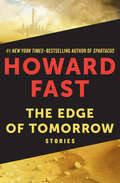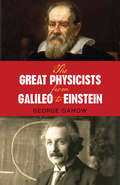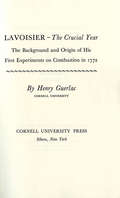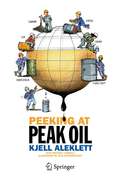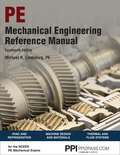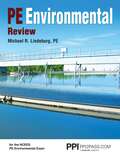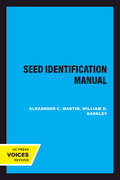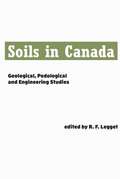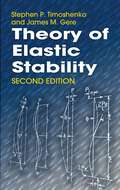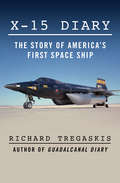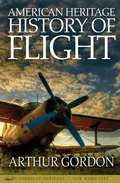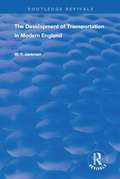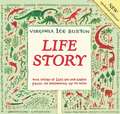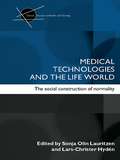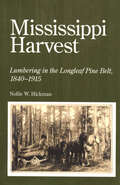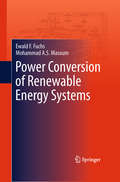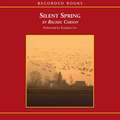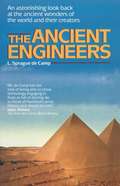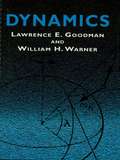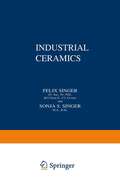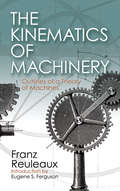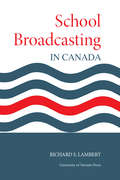- Table View
- List View
The Edge of Tomorrow: A Novel
by Howard FastScience fiction stories from the #1 New York Times–bestselling author of Spartacus. From one of the most prolific and versatile writers of the twentieth century, The Edge of Tomorrow is a collection of tales that journey outside everyday boundaries to offer insight into our own universe. Featuring big bugs, cloned cats, and feral star-children, these unconventional, thought-provoking stories reveal much about the America of their time, when the Cold War and the nascent civil rights movement stoked unconscious fears and desires. From &“The First Men,&” about scientists tampering with genetic engineering, to &“The Large Ant,&” about a man&’s thoughtless violence against nature, these stories by the author of April Morning and The Immigrants—described by the Los Angeles Times as &“one of our very best&”—are as relevant today as when they were first written. This ebook features an illustrated biography of Howard Fast including rare photos from the author&’s estate.
The Great Physicists from Galileo to Einstein
by George Gamow"This book is Gamow at his best, which means the very best in science for the layman." -- Library JournalWidely recognized as one of the 20th century's foremost physicists, George Gamow was also an unusually capable popularizer of science. His talents are vividly revealed in this exciting and penetrating explanation of how the central laws of physical science evolved -- from Pythagoras' discovery of frequency ratios in the 6th century B.C. to today's research on elementary particles.Unlike many books on physics which focus entirely on fact and theory with little or no historic detail, the present work incorporates fascinating personal and biographical data about the great physicists of past and present. Thus Dr. Gamow discusses on an equal basis the trail of Galileo and the basic laws of mechanics which he discovered, or gives his personal recollections about Niels Bohr along with detailed discussion of Bohr's atomic model. You'll also find revealing glimpses of Newton, Huygens, Heisenberg, Pauli, Einstein, and many other immortals of science.Each chapter is centered around a single great figure, or at most two, with other physicists of the era and their contributions forming a background. Major topics include the dawn of physics, the Dark Ages and the Renaissance, Newtonian physics, heat as energy, electricity, the relativistic revolution, quantum theory, and the atomic nucleus and elementary particles.As Dr. Gamow points out in the Preface, the aim of this book is to give the reader the feeling of what physics is, and what kind of people physicists are. This delightfully informal approach, combined with the book's clear, easy-to-follow explanations, will especially appeal to young readers but will stimulate and entertain science enthusiasts of all ages. 1961 edition."The whole thing is a tour de force covering all the important landmarks." -- Guardian
Lavoisier—the Crucial Year: The Background and Origin of His First Experiments on Combustion in 1772
by Henry GuerlacThe author explores the origins of the eighteenth-century chemical revolution as it centers on Antoine-Laurent Lavoisier's earliest work on combustion. He shows that the main lines of Lavoisier's theory—including his theory of a heat-fluid, caloric—were elaborated well before his discovery of the role played by oxygen. Contrary to the opinion prevailing at that time, Lavoisier suspected, and demonstrated by experiment, that common air, or some portion of it, combines with substances when they are burned.Professor Guerlac examines critically the theories of other historians of science concerning these first experiments, and tries to unravel the influences which French, German, and British chemists may have had on Lavoisier. He has made use of newly discovered material on this phase of Lavoisier's career, and includes an appendix in which the essential documents are printed together for the first time.
Peeking at Peak Oil
by Michael Lardelli Olle Qvennerstedt Kjell AleklettThe term "Peak Oil" was born in January 2001 when Colin Campbell formed the Association for the Study of Peak Oil & Gas (ASPO). Now, Peak Oil is used thousands of times a day by journalists, politicians, industry leaders, economists, scientists and countless others around the globe. Peak Oil is not the end of oil but it tells us the end is in sight. Anyone interested in food production, economic growth, climate change or global security needs to understand this new reality. In Peeking at Peak Oil Professor Kjell Aleklett, President of ASPO International and head of the world's leading research group on Peak Oil, describes the decade-long journey of Peak Oil from extremist fringe theory to today's accepted fact: Global oil production is entering terminal decline. He explains everything you need to know about Peak Oil and its world-changing consequences from an insider's perspective. In simple steps, Kjell tells us how oil is formed, discovered and produced. He uses science to reveal the errors and deceit of national and international oil authorities, companies and governments too terrified to admit the truth. He describes his personal involvement in the intrigues of the past decade. What happens when a handful of giant oil fields containing two thirds of our planet's oil become depleted? Will major oil consumers such as the EU and US face rationing within a decade? Will oil producing nations conserve their own oil when they realize that no one can export oil to them in the future? Does Peak Oil mean Peak Economic Growth? If you want to know the real story about energy today and what the future has in store, then you need to be "Peeking at Peak Oil".
PPI Mechanical Engineering Reference Manual, 14th Edition eText - 6 Months, 1 Year
by Michael R. Lindeburg PEComprehensive Reference Manual for the NCEES PE Mechanical Exams The Mechanical Engineering Reference Manual is the most comprehensive textbook for the three NCEES PE Mechanical exams: HVAC and Refrigeration, Machine Design and Materials, Thermal and Fluid Systems. This book&’s time-tested organization and clear explanations start with the basics to help you quickly get up to speed on common mechanical engineering concepts. Together, the 75 chapters provide an in-depth review of the PE Mechanical exam topics and the NCEES Handbook. Michael R. Lindeburg&’s Mechanical Engineering Reference Manual has undergone an intensive transformation in this 14th edition to ensure focused study for success on the 2020 NCEES computer-based tests (CBT). As of April 2020, exams are offered year-round at approved Pearson Vue testing centers. The only resource examinees can use during the test is the NCEES PE Mechanical Reference Handbook. To succeed on exam day, you need to know how to solve problems using that resource. The Mechanical Engineering Reference Manual, 14th Edition makes that connection for you by using only NCEES equations in the review and problem solving.Topics CoveredFluidsThermodynamicsPower CyclesHeat TransferHVACStaticsMaterialsMachine DesignDynamics and VibrationsControl SystemsPlant EngineeringEconomicsLaw and EthicsKey FeaturesImproved design to focus study on most important PE exam materialExplanations and demonstration of how to use NCEES handbook equationsNCEES handbook equations are highlighted in blue for quick accessIn chapter callouts map to the specific PE exam to streamline review processExtensive index contains thousands of entries, with multiple entries included for each topicBinding: HardcoverPublisher: PPI, A Kaplan Company
PPI PE Environmental Review eText - 1 Year
by Michael R. Lindeburg PEYou need this book for your CBT preparation! The PE Environmental CBT exam is NOT open book. You will only be allowed to use the NCEES supplied electronic reference on the exam. Ensure exam day success with the new PE Environmental Review from Michael R. Lindeburg, PE.PE Environmental Review offers the complete review for the new NCEES Environmental PE CBT exam. This book is the most up-to-date, comprehensive reference manual available, and is designed to the exact order of the exam.Topics CoveredWater: Principles, Wastewater, Stormwater, Potable Water, Water ResourcesAir: Principles, Pollution ControlSolid and Hazardous Waste: Principles, Municipal and Industrial Solid Waste, Hazardous, Medical, and Radioactive WasteSite Assessment and RemediationEnvironmental Health and SafetyAssociated Engineering PrinciplesAbout the Exam The NCEES PE Environmental CBT Exam is a 9-hour computer-based exam. It is closed book with an electronic reference. Examinees have 9 hours to complete the 80 question exam. The 9-hour time includes a tutorial and optional break. This exam uses both the International System of units (SI) and the US Customary System (USCS).Key Features: Easy to find content organized in same order as the examUse of NCEES Handbook equations, tables, and figuresTeaching of how to solve exam problems with specific NCEES Handbook equationsIndustry-standard terminology and nomenclatureEqual support of U.S. customary and SI unitsBinding: PaperbackPublisher: PPI, A Kaplan CompanyAfter you Pass Your PE Environmental Review will serve as an invaluable reference throughout your environmental engineering career.
Seed Identification Manual
by Alexander C. Martin William D. BarkleyThis title is part of UC Press's Voices Revived program, which commemorates University of California Press’s mission to seek out and cultivate the brightest minds and give them voice, reach, and impact. Drawing on a backlist dating to 1893, Voices Revived makes high-quality, peer-reviewed scholarship accessible once again using print-on-demand technology. This title was originally published in 1961.This title is part of UC Press's Voices Revived program, which commemorates University of California Press’s mission to seek out and cultivate the brightest minds and give them voice, reach, and impact. Drawing on a backlist dating to 1893, Voices Revived</DIV
Soils in Canada: Geological, Pedological and Engineering Studies (The Royal Society of Canada Special Publications #3)
by Robert LeggetThis work originated in a Symposium forming part of the programme for Section IV (Geological Sciences including Mineralogy) of the Royal Society of Canada, which met at Queen's University, Kingston, in 1960. Of wide scope, it demonstrates the progress now being made in Canada in the study of its vast area of soils. The papers of this Symposium are unique in that they present for the first time a combined picture of three aspects of soil science–the geological, the pedological (or agricultural), and the engineering (known as Soil Mechanics). The book serves, of course, mainly as an introduction to a large subject, but some more detailed papers give an idea of the depth as well as the wide range of soil studies in Canada today. The contents can be summarized as follows. First come seven papers on Pleistocene geology in Canada, followed by a study of muskeg (which forms half a million square miles of Canada's surface) and one of soil mineralogy. Four papers–one general and three regional–of pedological interest follow. Finally come four papers on soil mechanics: one relating agricultural and engineering soil studies; one discussing geology's influence on the siting and building of airports; a detailed account of the properties of Leda clay; and a general review of the soil problems facing the Canadian civil engineer.
Theory of Elastic Stability
by Stephen P. Timoshenko James M. GereThe best available guide to the elastic stability of large structures, this book introduces the principles and theory of structural stability. It was co-authored by the father of modern engineering mechanics, Stephen Timoshenko, and James Gere, who updated the materials and worked closely with Dr. Timoshenko. Relevant to aspects of civil, mechanical, and aerospace engineering, this classic covers the essentials of static and dynamic instabilities.Topics range from theoretical explanations of 2- and 3-D stress and strain to practical applications such as torsion, bending, thermal stress, and wave propagation through solids. Additional subjects include beam columns, curved bars and arches, buckling of rings, and experiments and design formulas. Particularly suitable for advanced undergraduate and graduate students of engineering, this volume is also an indispensable reference for professionals.
X-15 Diary: The Story of America's First Space Ship
by Richard TregaskisThe riveting true story of the world's fastest plane and the first manned flights into outer space. First tested in 1959, the X-15 rocket plane was at the forefront of the space race. Developed by the US Air Force and the National Aeronautics and Space Administration (NASA) in collaboration with North American Aviation, the X-15 was sleek, black, and powerful--a missile with stubby wings and a cockpit on the nose. By 1961 it could reach speeds over three thousand miles per hour and fly at an altitude of thirty-one miles above the earth's surface--the lower reaches of outer space. Acclaimed journalist and bestselling author Richard Tregaskis tells the story of the X-15's development through the eyes of the brave pilots and brilliant engineers who made it possible. From technological breakthroughs to disastrous onboard explosions to the bone-crushing effects of intense g-force levels, Tregaskis captures all the drama and excitement of this crucial proving ground for the Mercury, Gemini, and Apollo missions. X-15 Diary recounts a thrilling chapter in the history of the American space program and serves as a fitting tribute to the courageous scientists and adventurers who dared to go where no man had gone before. This ebook features an illustrated biography of Richard Tregaskis including rare images from the American Heritage Center at the University of Wyoming.
American Heritage History of Flight
by Arthur GordonPeople dreamed of flight for thousands of years. When we finally took to the skies, a new world opened up. This sweeping, superbly researched history from American Heritage details how various pioneers and innovators - from the Wright Brothers to Chuck Yeager - helped lift us into the sky.
Bonanza Girl
by Patricia BeattyA widow and her two children head for gold rush territory in Idaho, hoping to find jobs and a new life.
The Development of Transportation in Modern England (Routledge Revivals)
by William T. JackmanPublished in 1962: In offering this work as a modest contribution to our knowledge of the economic development of England from the standpoint of transportation, the author must say, in the first place that he has endeavoured to adhere rigidly to the subject in hand, withour making deviations into collateral fields
Fred Sanger Double Nobel Laureate
by George G. BrownleeConsidered 'the father of genomics', Fred Sanger (1918-2013) paved the way for the modern revolution in our understanding of biology. His pioneering methods for sequencing proteins, RNA and, eventually, DNA earned him two Nobel Prizes. He remains one of only four scientists (and the only British scientist) ever to have achieved that distinction. In this, the first full biography of Fred Sanger to be published, Brownlee traces Sanger's life from his birth in rural Gloucestershire to his retirement in 1983 from the Medical Research Council's Laboratory of Molecular Biology in Cambridge. Along the way, he highlights the remarkable extent of Sanger's scientific achievements and provides a real portrait of the modest man behind them. Including an extensive transcript of a rare interview of Sanger by the author, this biography also considers the wider legacy of Sanger's work, including his impact on the Human Genome Project and beyond.
Life Story
by Virginia Lee BurtonEarth takes center stage in this updated version of Virginia Lee Burton's 1962 classic Life Story. Told through five acts, Burton's art and text tell the history of earth from beginning to present day. Readers will gain an in-depth understanding of the planet's history and their leading roles in it today. The book has been updated with cutting-edge science, including up-to-the-minute information on fossil records and the geologic principles. We are thrilled to provide this updated artistic and visionary work in time for the anniversary of Virginia Lee Burton's 100th birthday.
Medical Technologies and the Life World: The social construction of normality (Critical Studies in Health and Society)
by Lars-Christer Hydén Sonja Olin LauritzenAlthough the use of new health technologies in healthcare and medicine is generally seen as beneficial, there has been little analysis of the impact of such technologies on people’s lives and understandings of health and illness. This ground-breaking book explores how new technologies not only provide hope for cure and well-being, but also introduce new ethical dilemmas and raise questions about the 'natural' body. Focusing on the ways new health technologies intervene into our lives and affect our ideas about normalcy, the body and identity, Medical Technologies and the Life World explores: how new health technologies are understood by lay people and patients how the outcomes of these technologies are communicated in various clinical settings how these technologies can alter our notions of health and illness and create ‘new illness’. Written by authors with differing backgrounds in phenomenology, social psychology, social anthropology, communication studies and the nursing sciences, this sensational text is essential reading for students and academics of medical sociology, health and allied studies, and anyone with an interest in new health technologies.
Mississippi Harvest: Lumbering in the Longleaf Pine Belt, 1840-1915
by Nollie W. HickmanIn this classic work of Mississippi history, Nollie W. Hickman relates the felling of great forests of longleaf pine in a southern state where lumbering became a mighty industry. Mississippi Harvest records the arduous transportation of logs to the mills, at first by oxcart and water and later by rail. It details how the naval stores trade flourished through the production of turpentine, pitch, and rosin and through the expansion of exports, which furnished France with spars for sailing vessels. The book tracks the impact of the Civil War on southern lumbering, the tragedy of denuded lands, and, finally, the renewal of resources through reforestation. Born into a family of lumbermen, Hickman acquired firsthand knowledge of forest industries. Later, as a student of history, he devoted years of painstaking work to gathering materials on lumbering. His information comes from many sources, including interviews with loggers, rafters, sawmill and turpentine workers, and company managers, and from company records, land records, diaries, old newspapers, lumber trade journals, and government documents. While the author's purpose is to share the history of a natural resource, he also gives the reader the panorama of Mississippi. Mississippi Harvest interprets the state's people, agriculture, industry, government, politics, economy, and culture through the lens of one of the state's earliest and most lasting economic engines.
Power Conversion of Renewable Energy Systems
by Mohammad A.S. Masoum Ewald F. FuchsPower Conversion of Renewable Energy Systems presents an introduction to conventional energy conversion components and systems, as well as those related to renewable energy. This volume introduces systems first, and then in subsequent chapters describes the components of energy systems in detail. Readers will find examples of renewable and conventional energy and power systems, including energy conversion, variable-speed drives and power electronics, in addition to magnetic devices such as transformers and rotating machines. Applications of PSpice, MATLAB, and Mathematica are also included, along with solutions to over 100 application examples. Power Conversion of Renewable Energy Systems aims to instruct readers how to actively apply the theories discussed within. It would be an ideal volume for researchers, students and engineers working with energy systems and renewable energy.
Principles of Aeroelasticity (Dover Books on Engineering)
by Holt Ashley Raymond L. BisplinghoffPrinciples of Aeroelasticity constitutes an attempt to bring order to a group of problems which have coalesced into a distinct and mature subdivision of flight vehicle engineering. The authors have formulated a unifying philosophy of the field based on the equations of forced motion of the elastic flight vehicle. A distinction is made between static and dynamic phenomena, and beyond this the primary classification is by the number of independent space variables required to define the physical system.Following an introductory chapter on the field of aeroelasticity and its literature, the book continues in two major parts. Chapters 2 through 5 give general methods of constructing static and dynamic equations and deal specifically with the laws of mechanics for heated elastic solids, forms of aerodynamic operators, and structural operators. Chapters 6 through 10 survey the state of aeroelastic theory. The chapters proceed from simplified cases which have only a small, finite number of degrees of freedom, to one-dimensional systems (line structures), and finally to two-dimensional systems (plate- and shell-like structures).Chapter 9 combines some of the previous results by treating the unrestrained elastic vehicle in flight. All these chapters assume linear systems with properties independent of time, but Chapter 10 takes up the subject of systems which must be represented by nonlinear equations or by equations with time varying coefficients.
Silent Spring
by Rachel Carson"In 1962, when Silent Spring was first published, 'environment' was not even an entry in the vocabulary of public policy. In a few cities, especially Los Angeles, smog had become a cause of concern, albeit more because of its appearance than because of its threat to public health. Conservation--the precursor of environmentalism--had been mentioned during the 1960 Democratic and Republican conventions, but only in passing and almost entirely in the context of national parks and natural resources. And except for a few scattered entries in largely inaccessible scientific journals, there was virtually no public dialogue about the growing, invisible dangers of DDT and other pesticides and chemicals. Silent Spring came as a cry in the wilderness, a deeply felt, thoroughly researched, and brilliantly written argument that changed the course of history. Without this book, the environmental movement might have been long delayed or never have developed at all."--Introduction, p. xv.
The Ancient Engineers: An Astonishing Look Back at the Ancient Wonders of the World and Their Creators
by L. Sprague de CampThe Pyramids of Giza, the Parthenon of Greece, the Great Wall of China, the Colosseum of Rome. Today, we stand in awe before these wonders of the ancient world. They hold our history and the deepest secrets of our past in their hidden recesses. In The Ancient Engineers, L. Sprague de Camp delves into the heart of the mystery. He introduces us to the master builders who had the vision, the power, and the passion to reach for the clouds and touch the heavens. We share in some of the greatest technological triumphs of all time--triumphs of the human mind, imagination, and spirit.
Dynamics (Dover Civil and Mechanical Engineering)
by Lawrence E. Goodman William H. WarnerBeginning text presents complete theoretical treatment of mechanical model systems and deals with technological applications. Topics include introduction to calculus of vectors, particle motion, dynamics of particle systems and plane rigid bodies, technical applications in plane motions, theory of mechanical vibrations, and more. Exercises and answers appear in each chapter.
The Kinematics of Machinery: Outlines of a Theory of Machines
by Eugene S. Ferguson Franz ReuleauxThis classic work explores the kinematics of machinery, chronicling the discovery and application of principles underlying the controlled movements within machines. Franz Reuleaux, the Father of Kinematics, writes with authority and precision about his original and incisive ideas, which have endured for more than a century. Developing the subject from its fundamentals, Reuleaux begins with a discussion of the nature of the machine problem. He advances to examinations of such topics as phoronomic propositions, pairs of elements, incomplete kinematic chains and notation, analysis of chamber-crank trains and complete machines, kinematic synthesis, and related subjects. More than 450 figures illustrate his descriptions. An excellent text for basic courses in kinematics, this volume also serves as a standard reference for professionals.
School Broadcasting in Canada
by Richard LambertThis book describes the origin, growth, and achievements of school broadcasting in Canada. Sections are devoted to the start of school broadcasting in each province, the establishment of national school broadcasts, and the work of the National Advisory Council on School Broadcasting. In the story, the part played by the Canadian Broadcasting Corporation in initiating and promoting the work of teaching by radio and in providing the facilities upon which it is based, is a significant one. The book is the first authoritative description, by the man largely responsible for its success, of an important and fruitful experiment in federal-provincial co-operation in the thorny field of education. To this co-operation is due the high standard of the school broadcasts which have earned for Canada world-wide recognition and appreciation. The book also describes the international aspects of this cooperation, particularly between Canada and Australia, Great Britain, and the United States.
